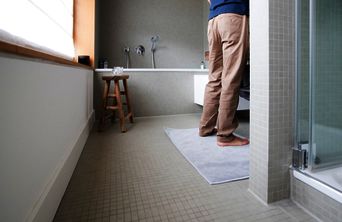Silicone – the ideal joint sealant in wet areas
Whether in new or in old buildings: joints in bathrooms, kitchens or around windows must be tightly sealed against the ingress of water and moisture. This not only prevents wear and tear, but also protects against mold infestation. It is advisable to choose the right products in order to protect the residents’ health and our environment.
1. Silicone – the first choice in wet areas
Acrylic joint sealants can be used for sealing transitions and have the advantage of being paintable. However, they are less elastic and not waterproof like silicone joint sealants. This type of sealant reliably seals expansion, edge, corner and connection joints. It prevents the penetration of water and cold, which can lead to damage or mold growth. Silicone is therefore the sealant of choice for all material transitions in bathrooms and kitchens.
2. Low-emission products – harmless to human health
Sanitary silicone contains fungicides that prevent an infestation with mold spores. However, these additives gradually lose their effect. In addition, the fungicide content is relatively low in order not to impair the residents’ health. If you want to be on the safe side, use low-emission silicone that has been awarded the EMICODE® seal. For 20 years, the EC1 seal has been granted to products that feature particularly low emissions. Based on a predefined quality standard with strict requirements, GEV EMICODE® certifies building products that are verifiably harmless to human health. EMICODE® also ensures that the environmental impact is as low as possible.
3. Proper drying and airing prevents mold attack
Even a silicone joint sealant will not last forever if it is not properly treated. To inhibit the formation of mold caused by moisture, all joints in the bathroom and shower should be cleaned with clear water and dried after use. Regular airing of wet rooms also helps to prevent fungal growth caused by air humidity.

©GEV
Share article on Social Media:
